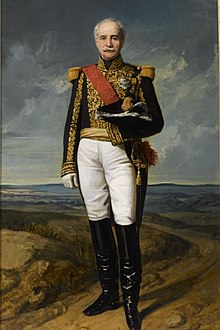This article includes a list of general references, but it lacks sufficient corresponding inline citations. (March 2009) |
Louis-Achille Baraguey d'Hilliers (6 September 1795 – 6 June 1878), 1st Comte Baraguey d'Hilliers, was a Marshal of France and politician.[1]
Achille Baraguey d'Hilliers | |
|---|---|
 Portrait by Charles-Philippe Larivière, 1857 | |
| Born | September 6, 1795 Paris, French First Republic |
| Died | June 6, 1878 (aged 82) Amélie-les-Bains, French Third Republic |
| Allegiance | France |
| Rank | Marshal of France |
| Commands | Constantine |
| Battles / wars | Battle of Möckern |
| Alma mater | Prytanée National Militaire |
| Relations | Louis Baraguey d'Hilliers |
| Other work | Politician |
Baraguey d'Hilliers was born in Paris,[2] the son of the French revolutionary general Louis Baraguey d'Hilliers. He was educated at the Prytanée National Militaire and joined the Grande Armée. Baraguey d'Hilliers served as a second lieutenant in the Russian campaign of 1812, and in 1813 was an aide-de-camp to Marshal Marmont at the Battle of Leipzig, where he lost his left hand.[1] Promoted to captain in 1815, he fought at Quatre Bras. In 1823, he served in the campaign to restore Bourbon power in Spain, where he remained until 1825.
He distinguished himself in Algeria, where he was promoted to colonel after the capture of Algiers in 1830. In 1834, Baraguey d'Hilliers was made vice-governor of the military academy of Saint Cyr, promoted to général de brigade in 1836, he was made commandant of the academy. Sent to Algeria in 1841, by 1843 he had been promoted to général de division and was made commandant of Constantine. Put on the non active list in 1844, by 1847 he was reinstated and made Inspector-General of infantry. After the Revolution of 1848, Nicolas Changarnier was sent as commanding general to Besançon and was elected to the constituent assembly for the department of Doubs.[1] He was one of the three candidates presented by President Louis-Napoléon Bonaparte for the office of vice president of the Republic; he received only one vote.[3] He was then appointed commander-in-chief of the French troops that invaded the revolutionary Roman Republic, in 1849, in the context of the First Italian War of Independence.[1]
In 1851, he replaced as commander of the army of Paris Nicolas Changarnier, whom President Napoleon Louis Bonaparte distrusted, and was a supporter of the latter's coup d'état later in that year.[1] In 1853, Baraguey d'Hilliers was sent to Constantinople as ambassador extraordinaire, and recalled in 1854. During the Crimean War he was given command of the expeditionary force destined for the Baltic Sea. After capturing Bomarsund, Baraguey d'Hilliers was promoted to Marshal of France and made a Senator of the French Second Empire. He would later serve as vice-president of the French Senate. During the Italian campaign of 1859, Baraguey d'Hilliers commanded the I Corps with which he distinguished himself by capturing the town of Solferino during the Battle of Solferino. After the war he was given command of V Corps in Tours.
Made governor of Paris in 1870, by his frankness he made himself unpopular with the Empress Eugénie and with Count Palikao. On 12 August, he was replaced by Trochu. After the end of the Franco-Prussian War, Adolphe Thiers made him president of a commission investigating the causes of the French defeat. He died in 1878 in Amélie-les-Bains.
Honours
edit- Second French Empire: Baton of Maréchal de France
- Second French Empire: Grand Croix of the Legion of Honour
- Second French Empire: Médaille militaire
- Second French Empire: Commemorative medal of the 1859 Italian Campaign
- Second French Empire: Saint Helena Medal
- United Kingdom: Crimea Medal
- Kingdom of Sardinia: Knight of the Supreme Order of the Most Holy Annunciation
- Kingdom of Sardinia: Grand Cross of the Order of Saints Maurice and Lazarus
References
edit- ^ a b c d e Ripley, George; Dana, Charles Anderson (1881). "BARAGUEY D'HILLIERS, I. Louis". American Cyclopædia. p. 295.
- ^ "BARAGUEY D'HILLIERS, ACHILLES (french)". Napoleon.org. Archived from the original on 4 March 2016. Retrieved 6 June 2015.
- ^ "Record of the National Assembly session of 20 January 1849". Compte rendu des séances de l'Assemblée nationale (in French). Vol. 7. Paris: Typographie Panckoucke. 1849. pp. 335–336. Retrieved 6 December 2022.